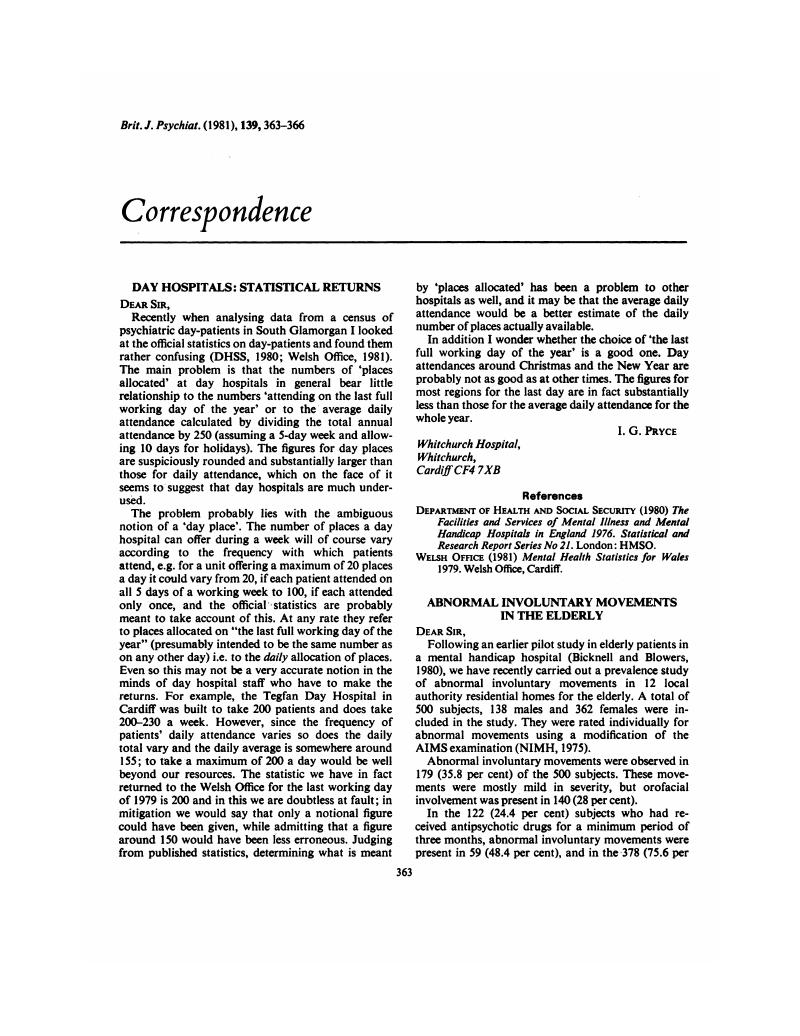Crossref Citations
This article has been cited by the following publications. This list is generated based on data provided by Crossref.
Barnes, T R
Rossor, M
and
Trauer, T
1983.
A comparison of purposeless movements in psychiatric patients treated with antipsychotic drugs, and normal individuals..
Journal of Neurology, Neurosurgery & Psychiatry,
Vol. 46,
Issue. 6,
p.
540.
Morgenstern, H
Glazer, W M
Niedzwiecki, D
and
Nourjah, P
1987.
The impact of neuroleptic medication on tardive dyskinesia: a meta-analysis of published studies..
American Journal of Public Health,
Vol. 77,
Issue. 6,
p.
717.
Ticehurst, Stephen B.
1990.
Is Spontaneous Orofacial Dyskinesia an Artefact Due to Incomplete Drug History?.
Journal of Geriatric Psychiatry and Neurology,
Vol. 3,
Issue. 4,
p.
208.
1991.
Not all that moves is tardive dyskinesia.
American Journal of Psychiatry,
Vol. 148,
Issue. 5,
p.
661.
1992.
Tardive Dyskinesia: A Task Force Report of the American Psychiatric Association.
p.
61.
Barnes, Thomas R. E.
1992.
Clinical assessment of the extrapyramidal side effects of antipsychotic drugs.
Journal of Psychopharmacology,
Vol. 6,
Issue. 2,
p.
214.
Ellenbroek, B.A.
1993.
Treatment of schizophrenia: A clinical and preclinical evaluation of neuroleptic drugs.
Pharmacology & Therapeutics,
Vol. 57,
Issue. 1,
p.
1.
2004.
Drug-Induced Movement Disorders.
Vol. 20045530,
Issue. ,
Blanchet, Pierre J.
Abdillahi, Ossob
Beauvais, Chantale
Rompré, Pierre H.
and
Lavigne, Gilles J
2004.
Prevalence of spontaneous oral dyskinesia in the elderly: A reappraisal.
Movement Disorders,
Vol. 19,
Issue. 8,
p.
892.
Nasrallah, Henry A.
2006.
Focus on Lower Risk of Tardive Dyskinesia with Atypical Antipsychotics.
Annals of Clinical Psychiatry,
Vol. 18,
Issue. 1,
p.
57.
Balasubramaniam, Ramesh
and
Ram, Saravanan
2008.
Orofacial Movement Disorders.
Oral and Maxillofacial Surgery Clinics of North America,
Vol. 20,
Issue. 2,
p.
273.
Pappa, S.
and
Dazzan, P.
2009.
Spontaneous movement disorders in antipsychotic-naive patients with first-episode psychoses: a systematic review.
Psychological Medicine,
Vol. 39,
Issue. 07,
p.
1065.
Clark, Glenn T.
and
Ram, Saravanan
2016.
Orofacial Movement Disorders.
Oral and Maxillofacial Surgery Clinics of North America,
Vol. 28,
Issue. 3,
p.
397.
Heir, Gary M.
and
de la Hoz, José L.
2017.
Orofacial Disorders.
p.
171.
Yoshida, Kazuya
2022.
Botulinum Toxin Therapy for Oromandibular Dystonia and Other Movement Disorders in the Stomatognathic System.
Toxins,
Vol. 14,
Issue. 4,
p.
282.
Ghadery, C. M.
Kalia, L. V.
and
Connolly, B. S.
2022.
Movement disorders of the mouth: a review of the common phenomenologies.
Journal of Neurology,
Vol. 269,
Issue. 11,
p.
5812.




eLetters
No eLetters have been published for this article.